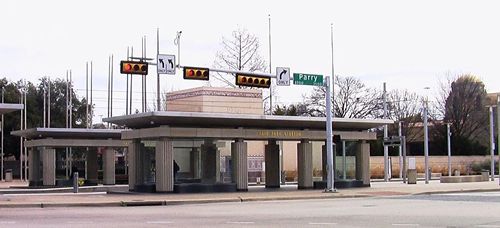|
Throughout
the latter part of the nineteenth century, Texans had a difficult
time commuting between the various cities, thanks to the relatively
rough, unsteady roads they had to traverse. All this disappeared around
the turn of the century with the introduction of the interurban railways.
First introduced to Dallas in 1901, the
railways used electric-powered trains between the main urban centers.
They covered five hundred miles of terrain, making Texas the state
with the second largest system west of the Mississippi River. The
Dallas-Fort
Worth area was responsible for seventy percent of this mileage.
The trains serving the interurban railways, though efficient in transporting
people between cities, could not help visitors and citizens travel
around the metropolitan areas. This problem was solved in Dallas
during 1925 when the Dallas Railway & Terminal Company started using
streetcars. Miniaturized versions of the electric train, they provided
easy access to Fair Park throughout the year and especially the state
fair. The trolleys played a critical part in the success of the Texas
Centennial by dropping off visitors at the main entrance near the
ticket booths on Parry Avenue. The company running them served as
a subsidiary of the Electric Power & Light Corporation until 1946
when it won independence. In 1955, it relinquished the ownership to
the Dallas Transit Company, which eliminated the last electric streetcar.
Lasting nine years, the DTC gave way to the Dallas Transit System.
The new owner managed to stay in charge until the final owner took
over in 1984.
Dallas Area Rapid Transit was formed after a special election held
on August 13, 1983. Fifteen cities in the Dallas-Fort
Worth area voted in favor of funding a regional transportation
system through a one-percent sales tax. Although DART took over operations
the following year, the DTC was technically in charge until 1988 when
the transition ended.
DART first introduced the idea of having a rail system in September
1984. Unfortunately, voters turned down a proposal in 1988 that would
allow the government to provide bonds to provide money for the project.
As a result, planners had to reduce the rail system's length to 84
miles. Construction began in 1990 and lasted for six years. On June
14th, the first eleven miles of the system opened to the public with
local celebrations and a week of free rides.
The rail service started in 1996 with the Red Line and Blue Line.
At the current time, the Blue Line currently connects residents of
Rowlett to Garland,
Northeast Dallas, Downtown Dallas, and Oak Cliff with future plans
of expansion. The Red Line serves Plano,
Richardson,
North Dallas, Downtown Dallas, and Oak Cliff. The Orange Line, which
opened in 2012, runs along the same route as the Red Line until it
arrives at West End Station. It then goes in the opposite direction
and makes stops at Las Colinas, Irving,
and D-FW Airport. In 2009, the Green Line began its service to the
public, providing transportation to Southeast Dallas, Northwest Dallas,
Farmer's
Branch, Carrollton,
and Fair Park. |
 |
Fair
Park Station
Photo courtesy Clint Skinner, February 2016 |
Fair Park Station
was one of four running during the first year with the other fifteen
soon to follow. Diana and Brad Goldberg, a husband and wife team of
artists, designed the train stop. Diana specialized in painting and
graphic design while Brad concentrated on sculptures and landscaping.
Together, they used their skills in developing a design which be a
respectful reflection of Fair Park and its history. They first studied
books, then proceeded to take pictures of the entire park. Through
this process, Diana and Brad found two references for inspiration.
The first one was the Hall of State and its art deco, chosen because
the building held great prominence during the Texas Centennial. The
second source was the group of ticket booths used for the grand event.
Combining these elements, the artists managed to design a train station
without the traditional barrel vault structure, which is used to protect
passengers from the weather.
August 28, 2016
© Clint
Skinner |
References:
1.Bigtex.com
2.Dallashistory.org
3.Dallas Morning News Archives
4.Fairpark.org
5.Slate, John H. Historic Dallas Parks. Arcadia Publishing, 2010.
6.Tshaonline.org
7.Watermelon-kid.com
8.Wikipedia.org
8.Winters, Willis Cecil. Fair Park. Arcadia Publishing, 2010. |
|
|
| Texas
Escapes, in its purpose to preserve historic, endangered and vanishing
Texas, asks that anyone wishing to share their local history, stories,
landmarks and vintage or recent photos, please contact
us. |
|
|
